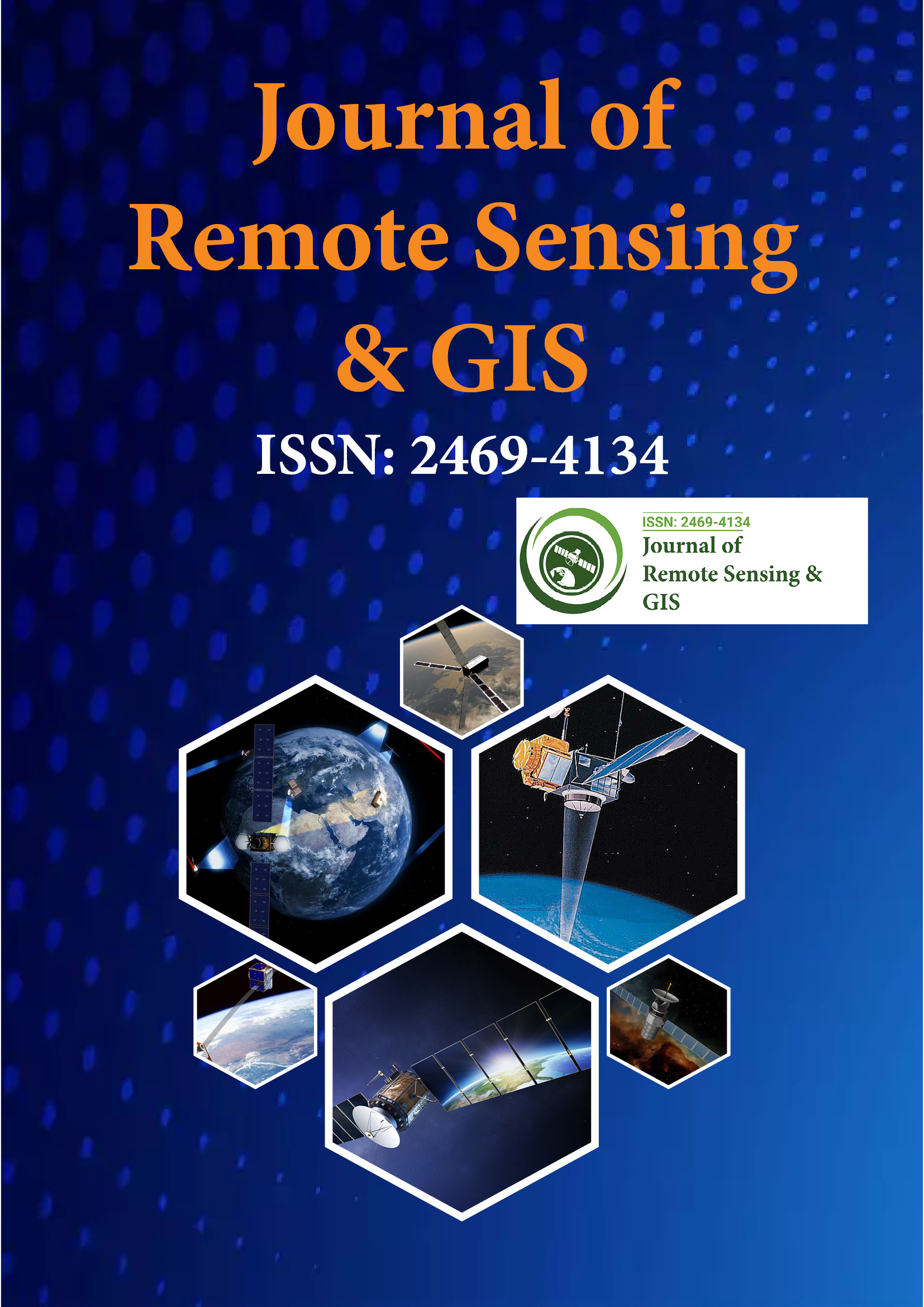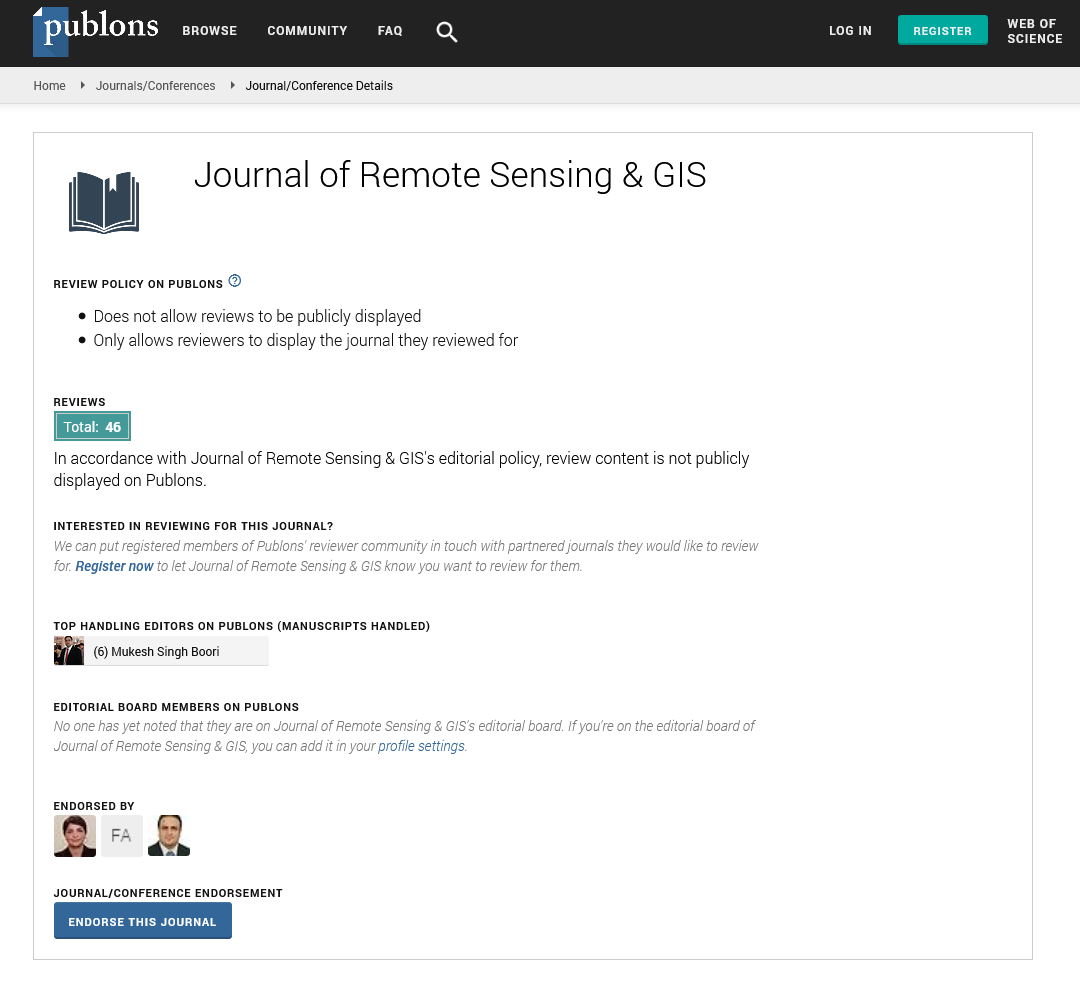Indexed In
- Open J Gate
- RefSeek
- Hamdard University
- EBSCO A-Z
- OCLC- WorldCat
- Publons
- International Scientific Indexing
- Euro Pub
- Google Scholar
Useful Links
Share This Page
Journal Flyer

Open Access Journals
- Agri and Aquaculture
- Biochemistry
- Bioinformatics & Systems Biology
- Business & Management
- Chemistry
- Clinical Sciences
- Engineering
- Food & Nutrition
- General Science
- Genetics & Molecular Biology
- Immunology & Microbiology
- Medical Sciences
- Neuroscience & Psychology
- Nursing & Health Care
- Pharmaceutical Sciences
Articles published in Journal of Remote Sensing & GIS have been cited by esteemed scholars and scientists all around the world. Journal of Remote Sensing & GIS has got h-index 26, which means every article in Journal of Remote Sensing & GIS has got 26 average citations.
Following are the list of articles that have cited the articles published in Journal of Remote Sensing & GIS.
| 2023 | 2022 | 2021 | 2020 | 2019 | 2018 | 2017 | 2016 | 2015 | 2014 | 2013 | 2012 | |
|---|---|---|---|---|---|---|---|---|---|---|---|---|
Total published articles |
59 | 61 | 76 | 48 | 13 | 31 | 34 | 33 | 18 | 25 | 11 | 13 |
Research, Review articles and Editorials |
9 | 11 | 54 | 15 | 13 | 30 | 34 | 33 | 16 | 20 | 8 | 12 |
Research communications, Review communications, Editorial communications, Case reports and Commentary |
50 | 50 | 22 | 33 | 0 | 1 | 0 | 0 | 2 | 5 | 3 | 1 |
Conference proceedings |
0 | 0 | 0 | 0 | 30 | 54 | 67 | 34 | 0 | 0 | 0 | 0 |
Citations received as per Google Scholar, other indexing platforms and portals |
375 | 451 | 419 | 285 | 214 | 136 | 73 | 0 | 0 | 0 | 0 | 0 |
| Journal total citations count | 2407 |
| Journal impact factor | 1.58 |
| Journal 5 years impact factor | 2.63 |
| Journal cite score | 4.47 |
| Journal h-index | 26 |
Important citations
Mapping the chlorophyll-a concentrations in hypereutrophic Krishnagiri Reservoir (India) using Landsat 8 Operational Land Imager
Re-initiating depth-discharge monitoring in small-sized ungauged watersheds by combining remote sensing and hydrological modelling: a case study in Madagascar
Pattern of Turbidity Change in the Middle Reaches of the Yarlung Zangbo River, Southern Tibetan Plateau, from 2007 to 2017
A machine learning-based strategy for estimating non-optically active water quality parameters using Sentinel-2 imagery
Detection and Monitoring of Marine Pollution Using Remote Sensing Technologies
Multispectral satellite data and GIS for mapping vector ecology, monitoring, risk assessment, and forecast of vector borne disease epidemics: a systematic review
Spatial and Temporal Analysis of Vector Borne Disease Epidemics for Mapping the Hotspot Region, Risk Assessment, and Control for Sustainable Health
Epidemiological situation and spatial distribution of visceral leishmaniasis in the Republic of Azerbaijan
Mapping the Geographical Distribution and Seasonal Variation of Dengue and Chikungunya Vector Mosquitoes (Aedes aegypti and Aedes albopictus) in the Epidemic Hotspot Regions of India: A Step towards the Vector Control and Sustainable Health
Spatial autocorrelation and epidemiological survey of visceral leishmaniasis in an endemic area of Azerbaijan region, the northwest of Iran
Modeling of Environmental Factors Affecting the Prevalence of Zoonotic and Anthroponotic Cutaneous, and Zoonotic Visceral Leishmaniasis in Foci of Iran: a Remote Sensing and GIS Based Study
Spatial Distribution of Phlebotomus argentipes (Diptera: Psychodidae) in Eastern India, a Case Study Evaluating Multispatial Resolution Remotely Sensed Environmental Evidence and Microclimatic Data
REMOTE SENSING AND GEOGRAPHIC INFORMATION SYSTEMS (GIS) AS THE APPLIED PUBLIC HEALTH & ENVIRONMENTAL EPIDEMIOLOGY
Environmental risk factors in relation to occurrence of vector borne disease epidemics: Remote sensing and GIS for rapid assessment, picturesque, and monitoring towards sustainable health
Environmental suitability for Lutzomyia longipalpis in a subtropical city with a recently established visceral leishmaniasis transmission cycle, Argentina
Distribution pattern of anthroponotic cutaneous leishmaniasis caused by Leishmania tropica in Western Afghanistan during 2013-2014
Spatial cognition: a geospatial analysis of vector borne disease transmission and the environment, using remote sensing and GIS
Situational Analysis of Visceral Leishmaniasis in the Most Important Endemic Area of the Disease in Iran
SIMILARIDE ANALYSIS BETWEEN BURNT AREAS MONITORING PRODUCTS FOR THE STATE OF ACRE
INTERCOMPARISON OF BURNED AREA PRODUCTS IN MATO GROSSO STATE

